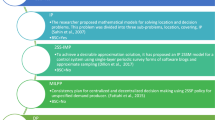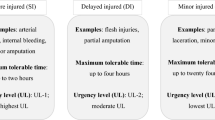Abstract
This research proposes a new multi-objective mathematical model to design efficient and effective blood supply chain network in earthquakes. For the first time in this field of knowledge, the devastating impact of earthquake destruction radius is considered on blood supply chain network based on its magnitude. Two different transportation means, with variant speed and capacity, are employed to carry the blood from blood collection centers to blood centers. However, the number of available conveyors is limited in each site. To solve the proposed multi-objective mixed integer linear programming model, five multi-objective decision making methods as well as the lexicographic weighted Tchebycheff method are utilized to provide the decision maker with Pareto optimal solutions. Further, the application of the proposed multi-objective mathematical model is investigated in a real-world case study using data from the latest earthquakes in one of the recent activated faults of Iran’s capital, Tehran, which is considered to be a potential place for a severe earthquake. Using different solution approaches, various Pareto optimal solutions are obtained for the case study. The results indicated that the proposed mathematical model is able to design the most cost and time efficient blood supply chain in a severe earthquake. At the end, sensitivity analyses are performed to explore the effects of any changes in main parameters of the multi-objective mathematical model on the objective functions value to demonstrate the most critical parameter.














Similar content being viewed by others
References
Abolghasemi, H., Radfar, M. H., Tabatabaee, M., Hosseini-Divkolayee, N. S., & Burkle, F. M., Jr. (2008). Revisiting blood transfusion preparedness: Experience from the Bam Earthquake. Prehospital and Disaster Medicine, 23(5), 391–4.
Akgün, İ., Gümüşbuğa, F., & Tansel, B. (2015). Risk based facility location by using fault tree analysis in disaster management. Omega, 52, 168–179.
Altay, N., & Green, W. G. (2006). OR/MS research in disaster operations management. European Journal of Operational Research, 175(1), 475–493.
American Association of Blood banks. (2008). Disaster operations handbook-hospital supplement (pp. 118–128).
Arvan, M., Tavakkoli-Moghaddam, R., & Abdollahi, M. (2015). Designing a bi-objective and multi-product supply chain network for the supply of blood. Uncertain Supply Chain Management, 3(1), 57–68.
Ballou, R. H. (1968). Dynamic warehouse location analysis. Journal of Marketing Research, 5(3), 271–276.
Banomyong, R., Varadejsatitwong, P., & Oloruntoba, R. (2017). A systematic review of humanitarian operations, humanitarian logistics and humanitarian supply chain performance literature 2005 to 2016. Annals of Operations Research. doi:10.1007/s10479-017-2549-5.
Beliën, J., & Forcé, H. (2012). Supply chain management of blood products: A literature review. European Journal of Operational Research, 217(1), 1–16.
Bozorgi-Amiri, A., & Asvadi, S. (2015). A prioritization model for locating relief logistic centers using analytic hierarchy process with interval comparison matrix. Knowledge-Based Systems, 86, 173–181.
Cheraghali, A. M. (2012). Overview of blood transfusion system of Iran: 2002–2011. Iranian Journal of Public Health, 41(8), 89.
Coles, J. B., Zhang, J., & Zhuang, J. (2017). Bridging the research-practice gap in disaster relief: Using the IFRC code of conduct to develop an aid model. Annals of Operations Research. doi:10.1007/s10479-017-2488-1.
Correia, I., Melo, T., & Saldanha-da-Gama, F. (2013). Comparing classical performance measures for a multi-period, two-echelon supply chain network design problem with sizing decisions. Computers & Industrial Engineering, 64(1), 366–380.
Daskin, M. S., Coullard, C. R., & Shen, Z. J. M. (2002). An inventory-location model: Formulation, solution algorithm and computational results. Annals of Operations Research, 110(1), 83–106.
Davoudi-kiakalayeh, A., Paridar, M., & Toogeh, G. (2012). Cost unit analysis of blood transfusion centers in Guilan province. Khoon, 1(9), 346–352.
De Maio, C., Fenza, G., Gaeta, M., Loia, V., & Orciuoli, F. (2011). A knowledge-based framework for emergency DSS. Knowledge-Based Systems, 24(8), 1372–1379.
Dillon, M., Oliveira, F., & Abbasi, B. (2017). A two-stage stochastic programming model for inventory management in the blood supply chain. International Journal of Production Economics, 187, 27–41.
Doocy, S., Daniels, A., Packer, C., Dick, A., & Kirsch T. D. (2013). The human impact of earthquakes: A historical review of events 1980–2009 and systematic literature review. PLoS Currents Disasters. doi:10.1371/currents.dis.67bd14fe457f1db0b5433a8ee20fb833.
Duhamel, C., Santos, A. C., Brasil, D., Châtelet, E., & Birregah, B. (2016). Connecting a population dynamic model with a multi-period location-allocation problem for post-disaster relief operations. Annals of Operations Research, 247(2), 693–713.
Fahimnia, B., Jabbarzadeh, A., Ghavamifar, A., & Bell, M. (2015). Supply chain design for efficient and effective blood supply in disasters. International Journal of Production Economics, 183, 700–709.
Galindo, G., & Batta, R. (2013). Review of recent developments in OR/MS research in disaster operations management. European Journal of Operational Research, 230(2), 201–211.
Hess, J. R., & Thomas, M. J. G. (2003). Blood use in war and disaster: Lessons from the past century. Transfusion, 43(11), 1622–1633.
Heydari, S. H., & Babai, O. K. (2015). Risk analysis on active faults of Tehran. In International conference on modern achievements in civil engineering, architecture, environment and urban management.
Hinojosa, Y., Puerto, J., & Fernández, F. R. (2000). A multiperiod two-echelon multicommodity capacitated plant location problem. European Journal of Operational Research, 123(2), 271–291.
Hosseinifard, Z., & Abbasi, B. (2016). The inventory centralization impacts on sustainability of the blood supply chain. Computers & Operations Research. doi:10.1016/j.cor.2016.08.014.
Huang, X., & Song, L. (2016). An emergency logistics distribution routing model for unexpected events. Annals of Operations Research. doi:10.1007/s10479-016-2300-7.
Hwang, C. L., & Masud, A. S. M. (2012). Multiple objective decision making—Methods and applications: A state-of-the-art survey (Vol. 164). Berlin: Springer.
Hwang, C. L., & Yoon, K. (1981). Multiple attribute decision making. Lecture notes in economics and mathematical systems (Vol. 186). Springer.
Jabbarzadeh, A., Fahimnia, B., & Seuring, S. (2014). Dynamic supply chain network design for the supply of blood in disasters: A robust model with real world application. Transportation Research Part E: Logistics and Transportation Review, 70, 225–244.
Jabbarzadeh, A., Jalali Naini, S. G., Davoudpour, H., & Azad, N. (2012). Designing a supply chain network under the risk of disruptions. Mathematical Problems in Engineering. doi:10.1155/2012/234324.
Jin, S., Jeong, S., Kim, J., & Kim, K. (2015). A logistics model for the transport of disaster victims with various injuries and survival probabilities. Annals of Operations Research, 230(1), 17–33.
Khalilpourazari, S., & Khalilpourazary, S. (2016). Optimization of production time in the multi-pass milling process via a Robust Grey Wolf Optimizer. Neural Computing and Applications. doi:10.1007/s00521-016-2644-6.
Khalilpourazari, S., & Khalilpourazary, S. (2017). A lexicographic weighted Tchebycheff approach for multi-constrained multi-objective optimization of the surface grinding process. Engineering Optimization, 49(5), 878–895.
Khalilpourazari, S., & Pasandideh, S. H. R. (2016). Bi-objective optimization of multi-product EPQ model with backorders, rework process and random defective rate. In 2016 12th International Conference on Industrial Engineering (ICIE) (pp. 36–40). IEEE.
Khalilpourazari, S., & Pasandideh, S. H. R. (2017). Multi-item EOQ model with nonlinear unit holding cost and partial backordering: Moth-flame optimization algorithm. Journal of Industrial and Production Engineering, 34(1), 42–51.
Khalilpourazari, S., Pasandideh, S. H. R., & Niaki, S. T. A. (2016). Optimization of multi-product economic production quantity model with partial backordering and physical constraints: SQP, SFS, SA, and WCA. Applied Soft Computing, 49, 770–791.
Kohneh, J. N., Teymoury, E., & Pishvaee, M. S. (2016). Blood products supply chain design considering disaster circumstances (Case study: Earthquake disaster in Tehran). Journal of Industrial and Systems Engineering, 9, 51–72.
Kuruppu, K. K. (2010). Management of blood system in disasters. Biologicals, 38(1), 87–90.
Leo, G., Lodi, A., Tubertini, P., & Di Martino, M. (2016). Emergency department management in Lazio, Italy. Omega, 58, 128–138.
Liang, L., Wang, X., & Gao, J. (2012). An option contract pricing model of relief material supply chain. Omega, 40(5), 594–600.
Mole, R. H. (1975). Inventory control in hospital blood banks. Omega, 3(4), 461–473.
Melo, M. T., Nickel, S., & Da Gama, F. S. (2006). Dynamic multi-commodity capacitated facility location: A mathematical modeling framework for strategic supply chain planning. Computers & Operations Research, 33(1), 181–208.
Nagurney, A., Masoumi, A. H., & Yu, M. (2012). Supply chain network operations management of a blood banking system with cost and risk minimization. Computational Management Science, 9(2), 205–231.
Nollet, K. E., Ohto, H., Yasuda, H., & Hasegawa, A. (2013). The Great East Japan earthquake of march 11, 2011, from the vantage point of blood banking and transfusion medicine. Transfusion Medicine Reviews, 27(1), 29–35.
Oloruntoba, R., Hossain, G. F., & Wagner, B. (2017). Theory in humanitarian operations research. Annals of Operations Research. doi:10.1007/s10479-016-2378-y.
Or, I., & Pierskalla, W. P. (1979). A transportation location-allocation model for regional blood banking. AIIE Transactions, 11(2), 86–95.
Osorio, A. F., Brailsford, S. C., Smith, H. K., Forero-Matiz, S. P., & Camacho-Rodríguez, B. A. (2016). Simulation-optimization model for production planning in the blood supply chain. Health Care Management Science. doi:10.1007/s10729-016-9370-6.
Pasandideh, S. H. R., Niaki, S. T. A., & Asadi, K. (2015). Optimizing a bi-objective multi-product multi-period three echelon supply chain network with warehouse reliability. Expert Systems with Applications, 42(5), 2615–2623.
Pierskalla, W. P. (2005). Supply chain management of blood banks. In M. L. Brandeau, F. Sainfort, & W. P. Pierskalla (Eds.), Operations research and health care. International series in operations research & management science (Vol. 70, pp. 103–145). Boston: Springer.
Pyakurel, U., Dhamala, T. N., & Dempe, S. (2017). Efficient continuous contraflow algorithms for evacuation planning problems. Annals of Operations Research, 254(1–2), 335–364.
Rodríguez, J. T., Vitoriano, B., & Montero, J. (2010). A natural-disaster management DSS for Humanitarian Non-Governmental Organisations. Knowledge-Based Systems, 23(1), 17–22.
Sabzehchian, M., Abolghasemi, H., Radfar, M. H., Jonaidi-Jafari, N., Ghasemzadeh, H., & Burkle, F. M. (2006). Pediatric trauma at tertiary-level hospitals in the aftermath of the Bam, Iran Earthquake. Prehospital and Disaster Medicine, 21(05), 336–339.
Şahin, G., Süral, H., & Meral, S. (2007). Locational analysis for regionalization of Turkish Red Crescent blood services. Computers & Operations Research, 34(3), 692–704.
Şahinyazan, F. G., Kara, B. Y., & Taner, M. R. (2015). Selective vehicle routing for a mobile blood donation system. European Journal of Operational Research, 245(1), 22–34.
Salehi, F., Mahootchi, M., & Husseini, S. M. M. (2017). Developing a robust stochastic model for designing a blood supply chain network in a crisis: A possible earthquake in Tehran. Annals of Operations Research. doi:10.1007/s10479-017-2533-0.
Samanlioglu, F. (2013). A multi-objective mathematical model for the industrial hazardous waste location-routing problem. European Journal of Operational Research, 226(2), 332–340.
Sha, Y., & Huang, J. (2012). The multi-period location-allocation problem of engineering emergency blood supply systems. Systems Engineering Procedia, 5, 21–28.
Shen, Z. J. M., Coullard, C., & Daskin, M. S. (2003). A joint location-inventory model. Transportation Science, 37(1), 40–55.
Steuer, R. E. (1986). Multiple criteria optimization: Theory, computation, and applications. London: Wiley.
Ülkü, M. A., Bell, K. M., & Wilson, S. G. (2015). Modeling the impact of donor behavior on humanitarian aid operations. Annals of Operations Research, 230(1), 153–168.
United States Geological Survey’s (USGS). http://earthquake.usgs.gov/.
Wang, X., Wu, Y., Liang, L., & Huang, Z. (2016). Service outsourcing and disaster response methods in a relief supply chain. Annals of Operations Research, 240(2), 471–487.
Xiang, Y., & Zhuang, J. (2016). A medical resource allocation model for serving emergency victims with deteriorating health conditions. Annals of Operations Research, 236(1), 177–196.
Yadavalli, V. S., Sundar, D. K., & Udayabaskaran, S. (2015). Two substitutable perishable product disaster inventory systems. Annals of Operations Research, 233(1), 517–534.
Yang, F., Yuan, Q., Du, S., & Liang, L. (2016). Reserving relief supplies for earthquake: A multi-attribute decision making of China Red Cross. Annals of Operations Research, 247(2), 759–785.
Zahiri, B., & Pishvaee, M. S. (2017). Blood supply chain network design considering blood group compatibility under uncertainty. International Journal of Production Research, 55(7), 2013–2033.
Zhang, Z. H., & Li, K. (2015). A novel probabilistic formulation for locating and sizing emergency medical service stations. Annals of Operations Research, 229(1), 813–835.
Author information
Authors and Affiliations
Corresponding author
Appendix
Rights and permissions
About this article
Cite this article
Khalilpourazari, S., Arshadi Khamseh, A. Bi-objective emergency blood supply chain network design in earthquake considering earthquake magnitude: a comprehensive study with real world application. Ann Oper Res 283, 355–393 (2019). https://doi.org/10.1007/s10479-017-2588-y
Published:
Issue Date:
DOI: https://doi.org/10.1007/s10479-017-2588-y




